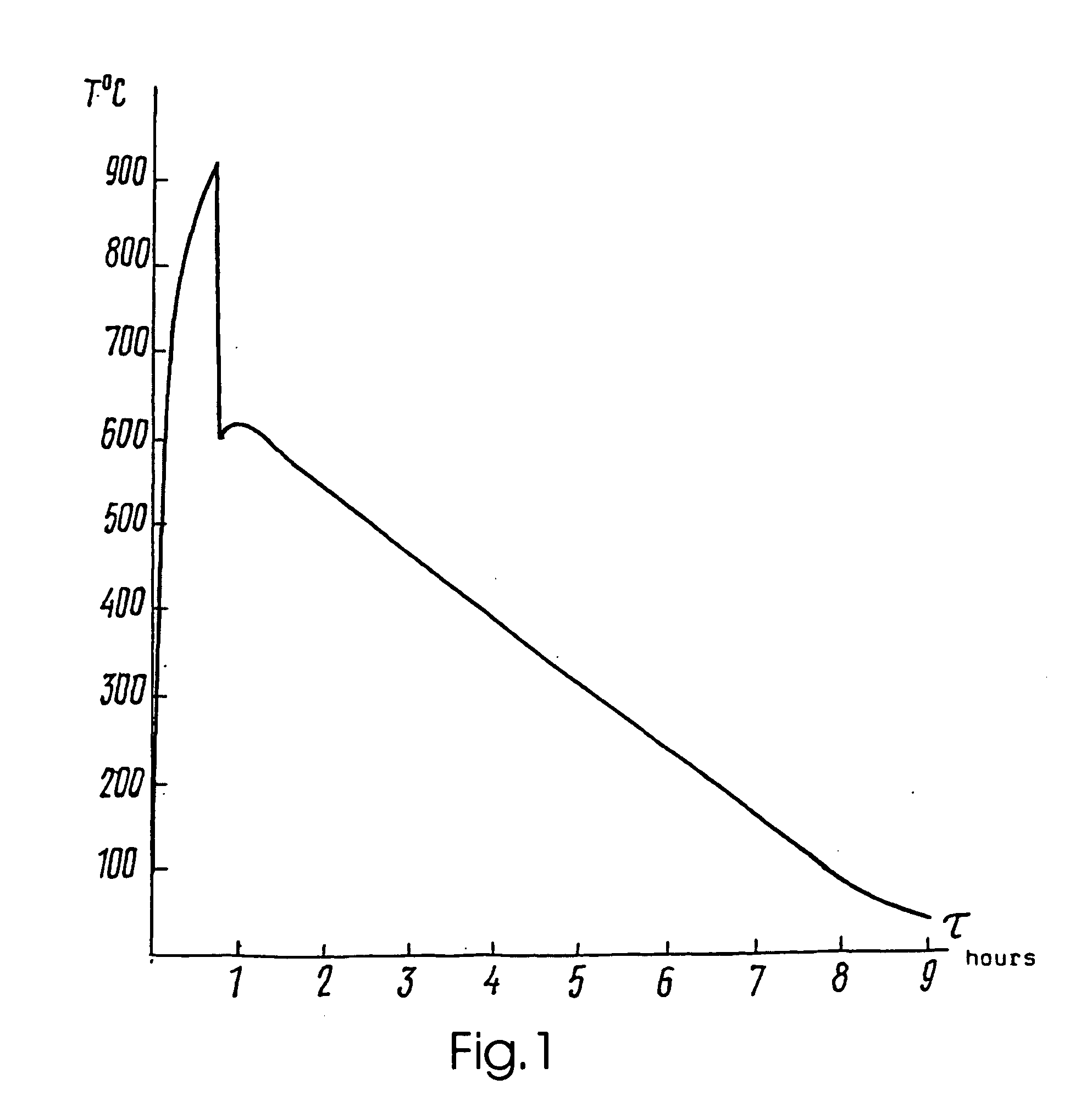Method for continous production of decorative facing slabs and a device for carrying out said method, decorative facing material
a production method and technology for decorative facings, applied in the direction of decorative arts, glass shaping apparatus, ornamental structures, etc., can solve the problems of low quality of firing slabs, warping and cracking, low quality of resulting slabs, etc., to reduce temperature differences, improve physico-mechanical, thermal and aesthetic properties, and expand the field of application
- Summary
- Abstract
- Description
- Claims
- Application Information
AI Technical Summary
Benefits of technology
Problems solved by technology
Method used
Image
Examples
example
[0078] The moulds of 330.times.430 mm in size that are made of quartz ceramics, are first cleaned of dust, dirt and stuck particles and then smeared inside with kaoline slip and dried.
[0079] A layer of quartz sand 2 mm thick and then a layer of mixture of colour glass pelletizer and refractory filler 20 mm thick (to produce a finished slab of 12 mm in thickness) and wetted to 4% moisture content are filled into a mould thus dried on the bottom, and the mixture is rammed.
[0080] In order to produce decorative facing slabs of light blue colour, use is made of colour glass pelletizer with the pellets of 1.6 mm to 5 mm in size and having the following chemical composition (wt. %): SiO.sub.2--60.0; Na.sub.2O--16.8; CaO--5.6; Al.sub.2O.sub.5--5.8; P.sub.2O.sub.5--9.1; NaNO.sub.3--1.5; CuSO.sub.4--0.8; CuO--0.4.
[0081] Four such moulds with homogeneous mixture filled in are placed into a recess of a heat-insulated pallet. The pallet is then placed under an electrical bell furnace preheated t...
example no.1
Example No. 1
[0096] (FIG. 5, Ref. Nos. 2 and 4, Black Sections)
[0097] Preliminarily prepared colour glass pelletizer (chemical composition and coefficients of linear thermal expansion are given in Table No. 1) with pellet size of 1.6 mm to 5.0 mm and quartz sand (percentages in the mixture are indicated in Table No. 1) with particle size of 0.15 mm to 0.4 mm are loaded into tared vessels; a hopper-type container for glass pelletizer (capacity 150 kg) and a container for quartz sand (capacity 40 kg). The quantity of quartz sand by weight in the decorative facing material was 22.5 kg.
[0098] Preliminarily, the mixer, use has been made of SBR-200 concrete mixer, is supplied with a dosed quantity of glass pelletizer which is wetted to have a moisture content of up to 4 percent and then mixed for as long as 5 minutes (prior to turning on, the concrete mixer window is tightly closed).
[0099] Next, a measuring vessel is used to load quartz sand therein, followed by additional mixing for 10 m...
example no.2
Example No. 2
[0104] (FIG. 5, Ref. No. 1)
[0105] All the operations are carried out as in Example No. 1, but prior to placing the moulds into the recess of the heat-insulated pallet, the entire face of the homogeneous layer of the mixture of colour glass pelletizer and quartz sand is additionally coated with a uniform layer of quartz sand 1 mm to 3 mm thick. After baking, the excess of quartz sand is easily removed from the upper layer by a stiff brush. As a result, a rough surface layer is formed which contains 100 wt. % quartz sand and is fused into glass pelletizer.
PUM
| Property | Measurement | Unit |
|---|---|---|
| thermal resistance | aaaaa | aaaaa |
| temperature | aaaaa | aaaaa |
| temperature | aaaaa | aaaaa |
Abstract
Description
Claims
Application Information
 Login to View More
Login to View More - R&D
- Intellectual Property
- Life Sciences
- Materials
- Tech Scout
- Unparalleled Data Quality
- Higher Quality Content
- 60% Fewer Hallucinations
Browse by: Latest US Patents, China's latest patents, Technical Efficacy Thesaurus, Application Domain, Technology Topic, Popular Technical Reports.
© 2025 PatSnap. All rights reserved.Legal|Privacy policy|Modern Slavery Act Transparency Statement|Sitemap|About US| Contact US: help@patsnap.com



